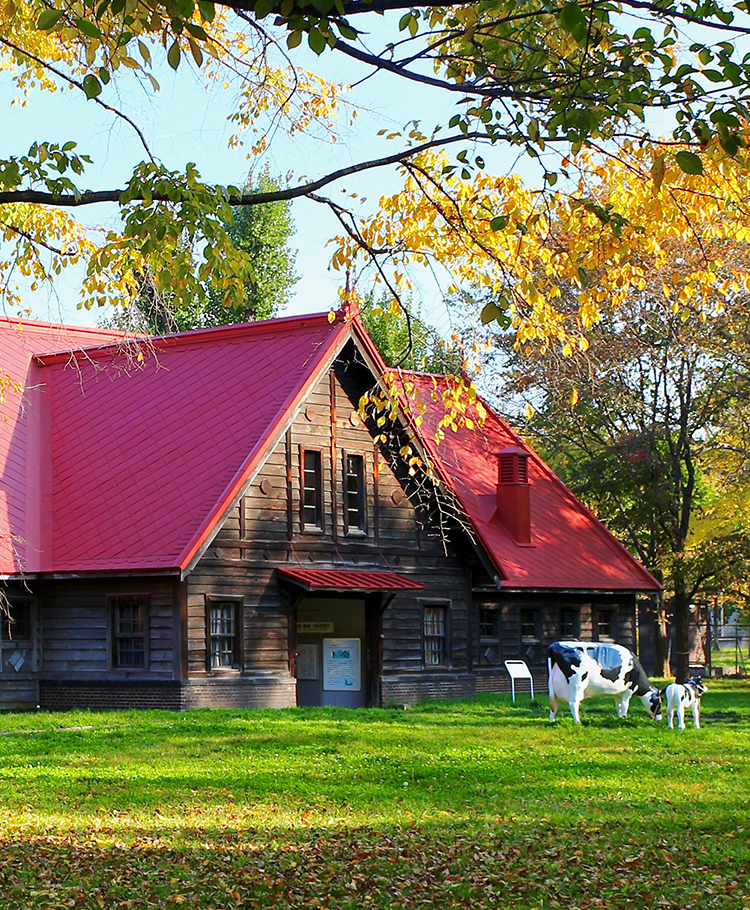Historical Village of Hokkaido

The Historical Village of Hokkaido is an open-air museum that showcases relocated, reconstructed, and preserved buildings from various parts of Hokkaido from the Meiji period to the early Showa period. The museum is split into several areas, categorized by urban, rural, mountain, and fishing architecture. Here, you'll find private homes, barbershops, newspaper offices, and government offices, recreating the landscape of Hokkaido over a century ago. One of the most eye-catching buildings here is the Hokkaido Colonization Commission Sapporo Main Office, which was in charge of developing the Sapporo region at the time. It burnt down in 1879 but was restored in this museum. The vivid contrast of green and white colors and the octagonal dome leave quite the impression. The village's main street is lined with a horse-drawn railway, which was used to transport people from the Meiji period to the early Showa period. Tour the area in a retro horse-drawn carriage for even more immersion. Take a trip back in time to the development days of Hokkaido!


See details on this destination
Matsumae Castle (Fukuyama Castle)

The Matsumae Castle (Fukuyama Castle) is said to be the only Japanese-style castle in Hokkaido and the last one built in Japanese history. In 1875, the Hokkaido Development Commission demolished a part of the castle and later rebuilt it. The castle's majestic appearance continues to attract many visitors even today. The Honmaru Gate (Ote-mon), the main gate of the Honmaru-goten Palace, is the only part remaining from Matsumae Castle at the time of its construction. You can feel the length of time that has passed over the years. The three-story castle tower commands a panoramic view of Tsugaru Straights and the castle town filled with the Edo atmosphere of old Tokyo. The museum inside features the Matsumae folding screen, armor, and other precious relics. Knowing the history of Matsumae is a key point in understanding the history of Hokkaido before its development.


See details on this destination
Herring Goten Otaru VIP Hall (Old Aoyama Villa)


During the Meiji period, when the development of Hokkaido began in earnest, herring fishing was so active in Otaru that it accounted for 80% of Hokkaido's total catch. The Aoyama family made a huge fortune from herring fishing in Otaru. They then spent six and a half years building their villa, currently the Old Aoyama Villa. Its total floor area is 627 square meters, with its total construction cost said to be approximately three billion yen at current prices. The zelkova lacquered pillars and flooring, the staircases made of richly-crafted Tamo wood, the cloisonne porcelain sliding door pulls, and the rest of the luxurious details are all evidence of its splendor back in its time. Its garden is full of tree peonies, Chinese peonies, hydrangeas, and other flowers that delight visitors every season.
See details on this destination
Hoheikan


Hoheikan was opened as a Western-style hotel in 1881 by the Hokkaido Development Commission. It is the oldest existing wooden hotel building in Japan and has a long history of being visited by emperors during the Meiji, Taisho, and Showa periods. The ultramarine blue that brightly colors its white exterior walls is a noble color made from lapis lazuli, a highly prized gemstone at the time. On the front roof shines a red five-pointed star, the symbol of the Hokkaido Development Commission. The European-style balcony, the elegantly curved and ornate lobby staircase, the curtains decorated with a traditional Japanese pattern of peony arabesques, and the marble-like plaster fireplace are a perfect fusion of Japanese and Western stylistic beauty. Most people would lose themselves in admiration of its beauty.
See details on this destination
Sapporo Agricultural College's Farm No. 2

Sapporo Agricultural College's Farm No. 2 was a farm facility built by the Hokkaido Development Commission in 1876, based on a concept made by Dr. Clark, the first vice-principal of Sapporo Agricultural College (currently Hokkaido University). Hokkaido's livestock industry was built on the model of this farm. It is also a registered Important Cultural Property of Japan. Its cattle barn, milk mill, and unique granary that was built entirely on stone pillars on stilts are still here even today. It is also known for its model livestock cell for cattle and horses. On the second floor, where the hay is stored, you will find a large space unique to its pillarless balloon frame structure. The farm's historical architecture is reminiscent of Hokkaido's development days, blending in with the lush green nature and creating a soothing pastoral landscape.
*The building's interior (pasture cattle barn, model livestock cells, granary) is temporarily closed off due to the pandemic.






